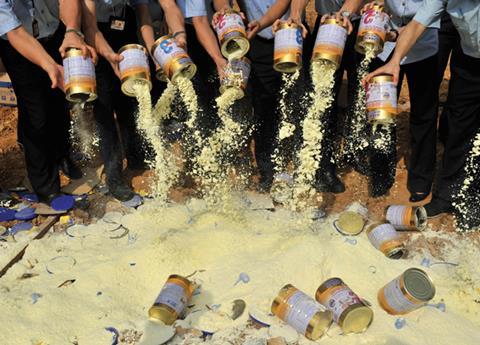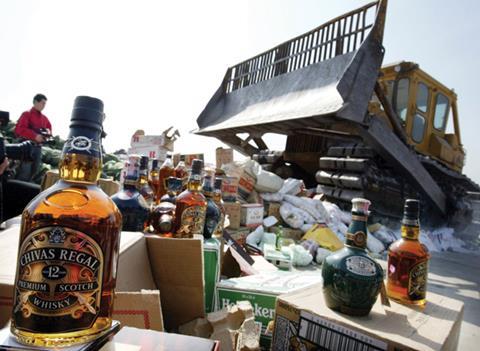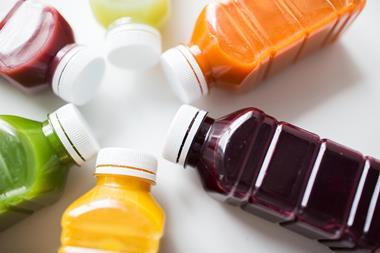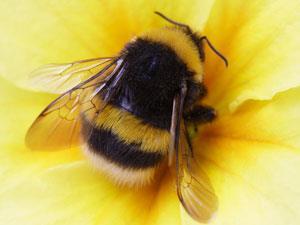After recent food scandals, analytical chemistry is more in demand than ever to reassure consumers, as Sarah Houlton discovers
We take it for granted that the food and drink we buy are what they say they are, and won’t harm us. It’s only when something goes badly wrong and negative headlines appear that we realise our trust can be misplaced, but food fraud comes in many forms and is not necessary deliberate. A product may be adulterated, containing undeclared or misidentified ingredients, or diluted. It may be contaminated maliciously, accidentally or adventitiously. The product might have been relabelled with a new expiry date to hide a finished shelf life. Or it could just be a fake.
Many of the most alarming headlines are reserved for product adulteration, which can pose huge public health risks. One of the worst examples was the 2008 Chinese scandal when nitrogen-rich aromatic compound melamine was added to powdered milk to increase its nitrogen content and, therefore, its apparent protein level. Six babies died, and more than 50,000 were hospitalised.We take it for granted that the food and drink we buy are what they say they are, and won’t harm us. It’s only when something goes badly wrong and negative headlines appear that we realise our trust can be misplaced, but food fraud comes in many forms and is not necessary deliberate. A product may be adulterated, containing undeclared or misidentified ingredients, or diluted. It may be contaminated maliciously, accidentally or adventitiously. The product might have been relabelled with a new expiry date to hide a finished shelf life. Or it could just be a fake.

Closer to home, traces of the banned genotoxic azo dye sudan 1 were found in a UK brand of Worcestershire sauce in 2005. Chemical detective work traced its source to adulterated chilli powder, and several hundred products containing the sauce were also withdrawn. Although no-one became ill, it highlights just how widespread one contamination incident can quickly become.
Not all product adulteration is a safety risk, but the detection of horsemeat in a variety of beef products such as burgers and pies still caused a huge outcry in the UK in 2013. Mechanically recovered chicken and turkey has also been found in lamb and beef products without a label declaration. And there have been substitution incidents where fish sold as cod or haddock in the local chippy is pollock or Vietnamese river cobbler.
Adulterated products
But there is a limit to what can be detected, explains Angus Knight, R&D manager for food safety and product integrity at Leatherhead Food Research in the UK. ‘People expect to be able to say there is no horsemeat in a product, but all you can say is that it’s less than a certain amount,’ he says. ‘For example, the [US Food & Drug Administration] FDA’s limits for accidental mixing imply that in tomato juice you can have four fly eggs and a maggot in every 100g, as that’s less than the limit of detection!’
Substitution also occurs in plant products, such as long grain rice masquerading as more expensive basmati or Thai jasmine rice. ‘Using a Thai fragrance spray on the rice can make it smell like the genuine article,’ says public analyst Liz Moran of Public Analyst Scientific Services in Norwich, UK. This precludes the use of sensory testing for identification, making DNA analysis the best technique.
Manufacturers have a tendency to underdeclare the fat content, and overdeclare the protein
Overdeclaration of the amount of meat in a product is common, with fat and gristle added to products such as sausages and meat pies. ‘We test the nitrogen content, and from that can work out protein levels,’ she says. ‘We also now look for the amino acid hydroxyproline, which is only found in gristle and skin, and from that we can work out how much connective tissue is present. Fat content is also measured.’ Combined with DNA testing to identify the animal, the proportions of ‘proper’ meat, fat and gristle can be calculated.
‘These tests can be applied to a variety of different foods to test nutrient content, so another thing we do is check the nutrition info on food products,’ Moran adds. ‘Manufacturers have a tendency to underdeclare the fat content, and overdeclare the protein.’
Not all food contamination is deliberate – it can arise during processing and handling, and as analytical techniques get more sensitive, minuscule amounts of sample can carry-over from one run to the next and are more likely to be detected. Trying to understand what might be expected to be found adds a further level of complexity. ‘If an abattoir had pushed through 100 tonnes of pork, how much pork might you expect to be in the next 100 tonnes of beef?’ says Ellen Norman, principal scientist for investigative analysis at Reading Scientific Services. ‘What constitutes fraud, and what normal working practices?’

The horsemeat incident also highlighted a real problem with analysis – the potential for false positives for rare events. Even if a test is 99% accurate, where an event occurs at a low frequency (say, one in 1000 samples), then a false positive result is 10 times more likely to occur than a true positive. ‘How many people appreciate this, and how many know the real accuracy of their test results, particularly for unvalidated tests?’ Knight says. As he explains, samples should always be divided into three – a sample for analysis, a sample retained by the owner, and a reference sample. Wherever possible, a validated testing method should be used, as they are the most difficult to challenge.
‘False positives have serious consequences, as a company may lose a contract as a result,’ Knight says. There are examples where test material that’s known to be just beef has generated a false positive for horse, yet samples known to contain horse gave a false negative.
Even if the species is as advertised, its origin can be mislabelled. DNA analysis is little help here, but isotope ratio analysis can give an insight into geographical source. ‘By looking at the ratios of the different isotopes of carbon, hydrogen, nitrogen and oxygen in meat or fish, we can work out what plants the animal was eating,’ Moran says.
The differences between British meat and beef imported from Argentina or lamb from New Zealand, for example, are significant. ‘Unknowns can be compared against a database of genuine samples to see if the isotope ratio matches,’ Moran says. ‘This can be used for any kind of food, whether plant or animal.’
‘As it’s diet related, the technique can also be used to tell the difference between wild and farmed fish,’ says Michael Walker, consultant science manager at lab services company LGC, based in Teddington, UK. ‘I’m happy to eat farmed salmon, but I want to know that it is farmed.’ There’s a real need for more data on the natural prevalence of isotope ratios and what the variation is.
Spotting the problems
Pinpointing a known adulterant in a food product is one thing. Finding an unknown one is another entirely. And even if an unexpected spike is spotted on a spectrum, what is it? ‘It could be just about anything,’ says John Spink of Michigan State University in the US, who is also director of its Food Fraud Initiative. The properties of a synthetic additive are fixed; an animal or vegetable ingredient is a moving target. ‘If the temperature goes up in Florida, the profile of the chemicals in an orange changes. So a spike may tell you something is different, but not that it’s bad or wrong.’ Non-targeted testing can help, by looking for a range of anomalies and then trying to analyse which are important enough to study in detail.
Of course, the real world isn’t like TV forensics – there is no magic box that will identify every unknown in a sample at the press of a button. ‘It can be difficult to explain to people that, unless we have a good idea what we’re looking for, it can be very difficult to find it,’ says Rachel Burch, chemistry research manager at Leatherhead Food Research.
The starting point for a chemist in identifying a contaminant is to ask questions about its origin. ‘The first thing I’d do is talk to the customer and ask where it’s come from and what they think might be the problem,’ Burch says. ‘It could just be a case of an ingredient behaving differently in their product – perhaps it’s less stable, or is causing instability. If the problem is with a new batch of an ingredient, we’d try to get a sample of “good” ingredient that had worked before. Have they changed the source?’
A sliver from the outside of a large block won’t tell you what’s in the centre
Food products are frequently complex mixtures, and without a reference it can be hard to pinpoint problems. ‘For an absolute unknown, we’d want a control product so we have something to compare it to,’ says Norman. ‘We’d start broad and cheap to narrow it down, and then use more expensive techniques. So we’d start with screening techniques like FTIR and NMR, and maybe x-ray microanalysis to understand the elemental profile and the organic material that’s present.’ If that shows up nothing, but there is evidence that the product’s not quite right, GC–MS or LC–MS might be applied. ‘But sometimes we don’t know if anything is wrong, and we are looking at two samples to see if they are different.’
Dilution makes the problem even more challenging, as was the case with Sudan 1. Adulteration might be easy to spot in the raw ingredient, but identifying tiny amounts of adulterant in the final food product is hard. If the adulterant is known, then more sensitive methods can work on food products, Burch says. There is now a drive to build up profiles of what NMR, FTIR and MS spectra should look like for different ingredients, allowing outliers to be spotted. ‘With so many variations in natural products, building such a database is a big job,’ Burch says.
And asking the right question is crucial, Walker says. ‘We don’t want to proliferate lots of number crunching for the sake of it,’ he says. ‘Why is the test or measurement being done – are there limits in laws or codes or practice for what the results should be? And is the sampling representative? A sliver from the outside of a large frozen block will not tell you what’s in the centre.’
Fakes and relabelling
Counterfeit products are particularly problematic in high-value fields where the potential returns are substantial, such as wine and spirits. They’ve become popular with organised criminals as the penalties for detection are much lower than drugs and gun-running.
RSSL does a lot of work on counterfeits, Norman says. Whereas fraud might involve the substitution of a cheaper ingredient, a counterfeit involves the wholesale hijacking of the supply chain. This was the case with fake Jacob’s Creek wine, which the eagle-eyed could spot as ‘Australia’ was incorrectly spelled on the bottle.
Fake vodka is alarmingly common. If it’s made with industrial alcohol, the product will likely be contaminated with methanol. ‘If you buy a bottle of vodka from someone in a pub car park for £5, it’s more than likely to make you extremely ill if you drink it,’ Moran claims. ‘There are also examples of vodkas contaminated with chloroform. As soon as one of these brands is detected and shut down, another seems to pop up somewhere else.’

But there’s more to it than just pinpointing chemical composition, particularly for fraud, such as relabelled out-of-date products. This hit McDonald’s in China last year, when a supplier was relabelling expired meat so it appeared to be OK. A product’s texture can be telling – a biscuit that is past its best will go soft, or a cake would be drier than it should be; a sweet might have gone tooth-breakingly hard, or chocolate bloomed. ‘Your analysis of fat and sugar would be the same, so you have to look at other things,’ Norman says. The packaging can be telling – microscope FTIR can be used to study the glue or the plastic in the packaging, as the ‘new’ packaging or the glue used to affix the replacement label might not be the same.
Prevention, not cure
One of the recommendations set out in a review commissioned from Chris Elliott of Queen’s University Belfast by the UK government in the light of the horsemeat scandal is to establish a network of expert labs. The hope is this will lead to validated and consistent test methods that can be accessed by trading standards and food companies around the world. ‘This will mean you’re not comparing one lab in Azerbaijan to another in the north of England, say, and being unable to tell how they did the testing and whether it’s fit for purpose,’ Norman says. ‘We’re hoping the network will strengthen those capabilities.’
We need to be vigilant when looking at the constantly shifting opportunity for food fraud
Prevention will always be more effective than reactive (or even proactive) detection and cure, particularly for something like product adulteration that can be so easy to disguise and so difficult to spot. Organisations such as the Global Food Safety Initiative work towards standardising food safety management system practices. Food fraud should be in its guidance document by the end of this year, and companies will be audited against it by the end of 2016.
‘Any countermeasure such as testing for melamine has to be judged not just by its ability to test whether melamine is present, but by its contribution to protection,’ Spink says. ‘That’s a key leap. How do we influence the supplier not to do this type of fraud? We need to tell them we are doing the test – if it’s done confidentially, you catch the product, but the goal is to get them not to put it in in the first place.’
Globalisation means a localised problem can rapidly cross borders and affect huge swathes of the world – as happened with the melamine in milk incident. Traceability throughout the supply chain is therefore a real help in prevention.
The increase in testing precision, allied to a growth in the availability of sophisticated testing equipment enabling more widespread testing, has been a real boon in identifying and removing problems from the food supply chain. ‘We have to keep monitoring,’ Spink says. ‘It’s not like fixing a broken leg where you set it and you’re done; it’s like diabetes, where the patient may look fine now but can go bad very quickly. We need to be vigilant when looking at the constantly shifting opportunity for food fraud.’
Sarah Houlton is a science writer based in Boston, US













No comments yet